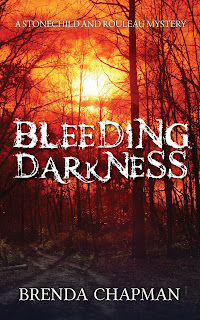"Dialogue is often hard to do right," he said. Give us your tips for writing killer dialogue.
Brenda Chapman at the keyboard.
Writing killer dialogue is one of those skills that takes time and practice to perfect. One of the best bits of advice I ever received came from my friend and fellow Ottawa author, Mary Jane Maffini. She was giving a workshop on dialogue and said, "Leave out the usual bits of everyday conversation and pare down to the essential." In other words, don't have your characters go on chatting about the weather, or what they ate for dinner, unless this is necessary for the plot. Dialogue in books doesn't replicate a normal conversation exactly. If it did, the reader would soon be bored into closing your book and putting it in the recycle bin.
So how to choose what to have your characters say?
I think like description, the test is to leave out the parts readers skip over. I'm constantly asking myself this question before I write a scene, "How is this going to move the story forward?" Dialogue must pass the same test. Every bit of dialogue should add something to progress the story, be it plot, character development, tension, conflict ...
I took this example from my latest Stonechild and Rouleau novel, Closing Time to show how a writer can use characters to get the reader asking questions and draw them in to the conflict. The characters, Martha and Shane, reference something that has already happened, a bit of history that I don't share until later in the story.
I'm using their conversation to set up the mystery and to start building the tension. I tend to use said and asked, sometimes added, and steer away from more descriptive verbs. This passage is unusual in that I rarely use adverbs, like softly, and only to hammer something home.
The following scene with dialogue from Bleeding Darkness reveals a lot about Lauren's relationship with her mother without me having to say much else. The night before this scene, Lauren spent the night getting drunk at a local bar.Lauren sat back down at the table with a full cup of coffee and took small sips while slumping in the chair with her eyes closed. She heard Clemmie’s nails clicking down the hallway toward the kitchen and then her mother’s footsteps. She straightened and tried to appear less ill than she felt as Evelyn stopped in the doorway and stared at her.
“My goodness, Lauren. You look as if you’re one step away from skid row.”
“Thanks Mother. You always know what to say to make me feel better about myself.”
“You’re not a child Lauren, although you often act like one. All I want is for you to pull yourself together and …”
“Find a husband, give you some grandkids and settle down to a life of servitude as you have. Not happening, Mother.” She stretched her fingers to the ceiling and yawned, feigning indifference while inside her stomach was churning and not only from the hangover.
This passage also shows that I avoid naming who is speaking after each bit of dialogue. I believe the rule is six (or is it eight) interactions before needing to clarify with 'he said' or 'she said', although descriptive text can negate the need altogether.
In my earliest books, I feel that I didn't use enough dialogue. I've gradually expanded the conversations between my characters. A good trick is to read the passages aloud to see if the vocabulary and rhythm sound natural.
I'm eager to read what my fellow bloggers have to say about this topic over the course of the week. Be sure to check back in as I will be!
Website: www.brendachapman.ca
Twitter: brendaAchapman
Facebook & Instagram: BrendaChapmanAuthor




9 comments:
Well said, Brenda.
Thanks Dietrich!
Definitely, dialogue takes practice, and ruthless editing. I find I have to go back through the piece and remove the throat clearing - “well, so, hi, Ann’s fir the tips, Brenda!
Sorry, I meant “Thanks for the tips” — autocorrect is not my friend.
Thanks Charlotte - Autocorrect gets me now and then too :-) Ruthless editing is painful but always necessary.
Good examples of how to do dialogue right, Brenda.
Thanks Susan!
Excellent advice, Brenda! Thanks,
Jim
Thanks Jim!
Post a Comment